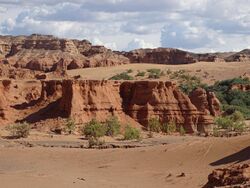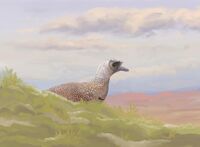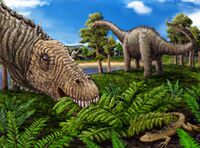Biology:Harenadraco
Harenadraco (meaning "sand dragon") is an extinct genus of troodontid theropod dinosaurs from the Late Cretaceous Baruungoyot Formation of Mongolia. The genus contains a single species, H. prima, known from a fragmentary skeleton. Harenadraco represents the first troodontid known from the Baruungoyot Formation. Since members of this family are also known from the Nemegt and Djadochta Formations, the discovery of Harendraco indicates that troodontids were important faunal components of every formation within the Nemegt Basin.
Discovery and naming
The Harenadraco holotype specimen, MPC-D 110/119, was discovered in 2018 in sediments of the Baruungoyot Formation (Hermiin Tsav locality) in Ömnögovi Province, Mongolia. The specimen consists of a fragmentary and partially articulated skeleton, comprising pieces of the right ilium, the end of the right femur, and several bones from the left hind leg, including the top of the femur, the end of the tibiotarsus, the second through fourth metatarsals, and several pedal phalanges. Some unidentified bone fragments are also associated with the skeleton.[1]
In 2024, Lee et al. described Harenadraco prima as a new genus and species of troodontid theropod based on these fossil remains. The generic name, Harenadraco , combines the Latin words "harena", meaning "sand", and "draco", meaning "dragon". The specific name, prima, is a Latin word meaning "first", referencing the fact that Harenadraco is the first troodontid known from its geological formation.[1]
Classification
In their phylogenetic analyses, Lee et al. (2024) recovered Harenadraco, along with an unnamed specimen from the Wulansuhai Formation, as the earliest diverging members of an otherwise entirely Chinese clade of troodontids. This clade is the sister taxon to all other troodontids. Their results are displayed in the cladogram below:[1]
| Troodontidae |
| ||||||||||||||||||||||||||||||||||||||||||||||||||||||||||||||||||||||||||||||||||||||||||||||||
Paleoecology
Harenadraco is known from the Hermiin Tsav locality of the Baruungoyot Formation.[1] This locality is known for its abundant dinosaur remains. Based on stratigraphy and fossil content, the formation is consistently regarded as Late Cretaceous (possibly Upper Campanian) in age, although radiometric dates have not been determined.[3]
Paleoenvironment
The Baruungoyot Formation is largely characterized by red beds, with many light-colored well-cemented sands (yellowish, grey-brown, and some reddish). Some sandy claystones (often red-colored), siltstones, conglomerates, and cross-bedded sands are also common. The formation's geology indicates that sediments were likely deposited under relatively arid to semiarid climates in alluvial plain (flat land consisting of sediments deposited by highland rivers), lacustrine (lake), and aeolian (wind-shaped) paleoenvironments, with occasional short-lived water bodies.[3][4][5]
Contemporary fauna
Fossil remains of many vertebrates have been found in various layers of the Baruungoyot Formation. Most notably, dinosaurs are some of the most abundant, with many species having been described. Maniraptoran theropods are especially common, including dromaeosaurids (Hulsanpes, Kuru, Natovenator, and Shri),[6][7][8] oviraptorids (Conchoraptor, Heyuannia and Nemegtomaia),[9] alvarezsaurids (Ceratonykus, Jaculinykus, Khulsanurus, Ondogurvel, and Parvicursor),[10] and birds (Gobipipus, Gobipteryx and Hollanda).[11][12] Remarkably, Harenadraco is the first troodontid known from this formation, despite the fact that the Nemegt and Djadochta Formations—the other two similarly aged geological formations in the Mongolian Nemegt Basin—both preserve multiple troodontid taxa.[1]
Several non-theropod dinosaurs are also present, including the titanosaurian sauropod (Quaesitosaurus),[13] ankylosaurids (Saichania, Tarchia and Zaraapelta),[14] protoceratopsids (Bagaceratops and Breviceratops),[15] and a pachycephalosaurid (Tylocephale).[16]
Non-dinosaurian animals from the formation include several fossil fish, amphibians, turtles, and many lizards and mammals (including djadochtatheriids, eutherians, multituberculates, and tribosphenidans).[17]
References
- ↑ 1.0 1.1 1.2 1.3 1.4 Lee, S.; Lee, Y.-N.; Park, J.-Y.; Kim, S.-H.; Badamkhatan, Z.; Idersaikhan, D.; Tsogtbaatar, K. (2024). "The first troodontid (Dinosauria: Theropoda) from the Upper Cretaceous Baruungoyot Formation of Mongolia". Journal of Vertebrate Paleontology 43 (6): e2364746. doi:10.1080/02724634.2024.2364746.
- ↑ 2.0 2.1 Wang, Shuo; Zhang, Qiyue; Tan, Qingwei; Jiangzuo, Qigao; Zhang, Huitao; Tan, Lin (2021-07-23). "New troodontid theropod specimen from Inner Mongolia, China clarifies phylogenetic relationships of later-diverging small-bodied troodontids and paravian body size evolution" (in en). Cladistics 38 (1): 59–82. doi:10.1111/cla.12467. ISSN 0748-3007. PMID 35049080.
- ↑ 3.0 3.1 Gradziński, R.; Jerzykiewicz, T. (1974). "Sedimentation of the Barun Goyot Formation". Palaeontologia Polonica 30: 111−146. http://www.palaeontologia.pan.pl/Archive/1974_30_111-146_34-42.pdf.
- ↑ Gradziński, R.; Jaworowska, Z. K.; Maryańska, T. (1977). "Upper Cretaceous Djadokhta, Barun Goyot and Nemegt formations of Mongolia, including remarks on previous subdivisions". Acta Geologica Polonica 27 (3): 281–326. https://geojournals.pgi.gov.pl/agp/article/view/9555/8104.
- ↑ Eberth, D. A. (2018). "Stratigraphy and paleoenvironmental evolution of the dinosaur-rich Baruungoyot-Nemegt succession (Upper Cretaceous), Nemegt Basin, southern Mongolia". Palaeogeography, Palaeoclimatology, Palaeoecology 494: 29–50. doi:10.1016/j.palaeo.2017.11.018. Bibcode: 2018PPP...494...29E.
- ↑ Cau, A.; Madzia, D. (2018). "Redescription and affinities of Hulsanpes perlei (Dinosauria, Theropoda) from the Upper Cretaceous of Mongolia". PeerJ 6: e4868. doi:10.7717/peerj.4868. PMID 29868277.
- ↑ Lee, S.; Lee, Y.-N.; Currie, P. J.; Sissons, R.; Park, J.-Y.; Kim, S.-H.; Barsbold, R.; Tsogtbaatar, K. (2022). "A non-avian dinosaur with a streamlined body exhibits potential adaptations for swimming". Communications Biology 5 (1185): 1185. doi:10.1038/s42003-022-04119-9. ISSN 2399-3642. PMID 36456823.
- ↑ Napoli, J. G.; Ruebenstahl, A. A.; Bhullar, B.-A. S.; Turner, A. H.; Norell, M. A. (2021). "A New Dromaeosaurid (Dinosauria: Coelurosauria) from Khulsan, Central Mongolia". American Museum Novitates (3982): 1–47. doi:10.1206/3982.1. ISSN 0003-0082. https://digitallibrary.amnh.org/bitstream/handle/2246/7286/3982.pdf?sequence=1&isAllowed=y.
- ↑ Funston, G. F.; Mendonca, S. E.; Currie, P. J.; Barsbold, R.; Barsbold, R. (2018). "Oviraptorosaur anatomy, diversity and ecology in the Nemegt Basin". Palaeogeography, Palaeoclimatology, Palaeoecology 494: 101–120. doi:10.1016/j.palaeo.2017.10.023. Bibcode: 2018PPP...494..101F.
- ↑ Kubo, Kohta; Kobayashi, Yoshitsugu; Chinzorig, Tsogtbaatar; Tsogtbaatar, Khishigjav (2023-11-15). "A new alvarezsaurid dinosaur (Theropoda, Alvarezsauria) from the Upper Cretaceous Baruungoyot Formation of Mongolia provides insights for bird-like sleeping behavior in non-avian dinosaurs" (in en). PLOS ONE 18 (11): e0293801. doi:10.1371/journal.pone.0293801. ISSN 1932-6203. PMID 37967055. Bibcode: 2023PLoSO..1893801K.
- ↑ Bell, A. K.; Chiappe, L. M.; Erickson, G. M.; Suzuki, S.; Watabe, M.; Barsbold, R.; Tsogtbaatar, K. (2010). "Description and ecologic analysis of Hollanda luceria, a Late Cretaceous bird from the Gobi Desert (Mongolia)". Cretaceous Research 31 (1): 16−26. doi:10.1016/j.cretres.2009.09.001. Bibcode: 2010CrRes..31...16B. https://www.researchgate.net/publication/229349737.
- ↑ Kurochkin, E. N.; Chatterjee, S.; Mikhailov, K. E. (2013-12-01). "An embryonic enantiornithine bird and associated eggs from the cretaceous of Mongolia" (in en). Paleontological Journal 47 (11): 1252–1269. doi:10.1134/S0031030113110087. ISSN 1555-6174. Bibcode: 2013PalJ...47.1252K. https://doi.org/10.1134/S0031030113110087.
- ↑ Kurzanov, S. M.; Bannikov, A. F. (1983). "A new sauropod from the Upper Cretaceous of Mongolia". Paleontological Journal 2: 90−96. https://moam.info/a-new-sauropod-from-the-upper-cretaceous-of-mongolia_5b764105097c4785168b45fe.html.
- ↑ Park, J.-Y.; Lee, Y. N.; Currie, P. J.; Ryan, M. J.; Bell, P.; Sissons, R.; Koppelhus, E. B.; Barsbold, R. et al. (2021). "A new ankylosaurid skeleton from the Upper Cretaceous Baruungoyot Formation of Mongolia: its implications for ankylosaurid postcranial evolution". Scientific Reports 11 (4101): 4101. doi:10.1038/s41598-021-83568-4. PMID 33737515.
- ↑ Czepiński, Ł. (2019). "Ontogeny and variation of a protoceratopsid dinosaur Bagaceratops rozhdestvenskyi from the Late Cretaceous of the Gobi Desert". Historical Biology 32 (10): 1394–1421. doi:10.1080/08912963.2019.1593404. http://dinosaurmailinglist.cmnh.org/2019Apr/pdfzmfpMk1aO4.pdf.
- ↑ Sullivan, R. M. (2006). "A taxonomic review of the Pachycephalosauridae (Dinosauria: Ornithischia)". New Mexico Museum of Natural History and Science Bulletin (35): 347–365. https://www.researchgate.net/publication/240625747.
- ↑ Jerzykiewicz, Tomasz; Currie, Philip J.; Fanti, Federico; Lefeld, Jerzy (2021-02-10). "Lithobiotopes of the Nemegt Gobi Basin" (in en). Canadian Journal of Earth Sciences 58 (9): 829–851. doi:10.1139/cjes-2020-0148. ISSN 0008-4077. https://tspace.library.utoronto.ca/bitstream/1807/106213/1/cjes-2020-0148.pdf.
Template:Troodontidae Wikidata ☰ {{{from}}} entry
 |




